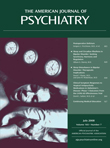Interpreting T Scores and Percentile Equivalents Using the MATRICS Consensus Cognitive Battery in Schizophrenia Trials
To the Editor: In the February 2008 issue of the Journal , Robert S. Kern, Ph.D. et al. (1) presented normative data for the National Institute of Mental Health’s Measurement and Treatment Research to Improve Cognition in Schizophrenia (MATRICS) Consensus Cognitive Battery. The authors are to be congratulated for conducting a rigorous study that facilitated co-norming and standardization for MATRICS Consensus Cognitive Battery (MCCB) test scores. The resulting normative-derived T scores are useful metrics for assessing the degree of normality or abnormality of any given test score. However, it should be noted that raw test scores need to follow a symmetrical and asymptotic normal distribution curve. Even for a cognitive test with normal distribution in the general population, normality assumptions may still be violated in a schizophrenia population known for significant cognitive deficits. Extreme standard T scores may be observed in the latter population, making the assessment of percentile equivalents and valid interpretations difficult. For example, extreme standard T scores in a schizophrenia population can be as low as 36 (i.e., 1.4 standard deviations below normal) or 20 for some tests (i.e., 3 standard deviations below the healthy comparison mean) (2 , 3) . Because these values lie at the tail of the normal distribution curve, a 10-point difference between T scores of 35 and 25 produces only 6.4 percentile points relative to 34 percentile points derived from a difference between T scores of 50 and 40. Thus, interpretation of the differences between two standard T scores and their percentile equivalents can be misleading, depending on where the two T scores fall on the normal curve.
An additional point to consider when using T scores is the requirement for extrapolation when the normative sample is not large enough to include data points that are close to the actual scores. For example, the estimated prevalence for a T score of 25 (2.5 standard deviations below the mean) is only 2 in 320 subjects. It would have been useful if the authors had provided the range, in addition to the standard deviation, of the raw test scores in the normative sample. Recognizing these issues in using the T score and its percentile equivalent is important for the analysis and valid interpretation of these normative-derived standard scores.
1. Kern RS, Nuechterlein KH, Green MF, Baade LE, Fenton WS, Gold JM, Keefe RSE, Mesholam-Gately R, Mintz J, Seidman LJ, Stover E, Marder SR: The MATRICS Consensus Cognitive Battery, Part 2: co-norming and standardization. Am J Psychiatry 2008; 165:214–220Google Scholar
2. Harvey PD, Keefe RSE: Cognitive impairment in schizophrenia and implications of atypical neuroleptic treatment. CNS Spectr 1997; 2:1–11Google Scholar
3. Keefe RSE, Bilder RM, Harvey PD, Davis SM, Palmer BW, Gold JM, Meltzer HY, Green MF, Miller DD, Canive JM, Adler LW, Manschreck TC, Swartz M, Rosenheck R, Perkins DO, Walker TM, Stroup TS, McEvoy JP: Baseline neurocognitive deficits in the CATIE schizophrenia trial. Neuropsychopharmacology 2006; 31:2033–2046Google Scholar



